This easy vegan vegetable curry recipe is the best for simple, no-fuss cooking and is packed with amazing traditional curry flavours. This curry is just so versatile and budget-friendly as any veggies you have to hand can be chucked in. Especially any veggies that you can find with reduced stickers or labels are perfect for this family favourite curry.
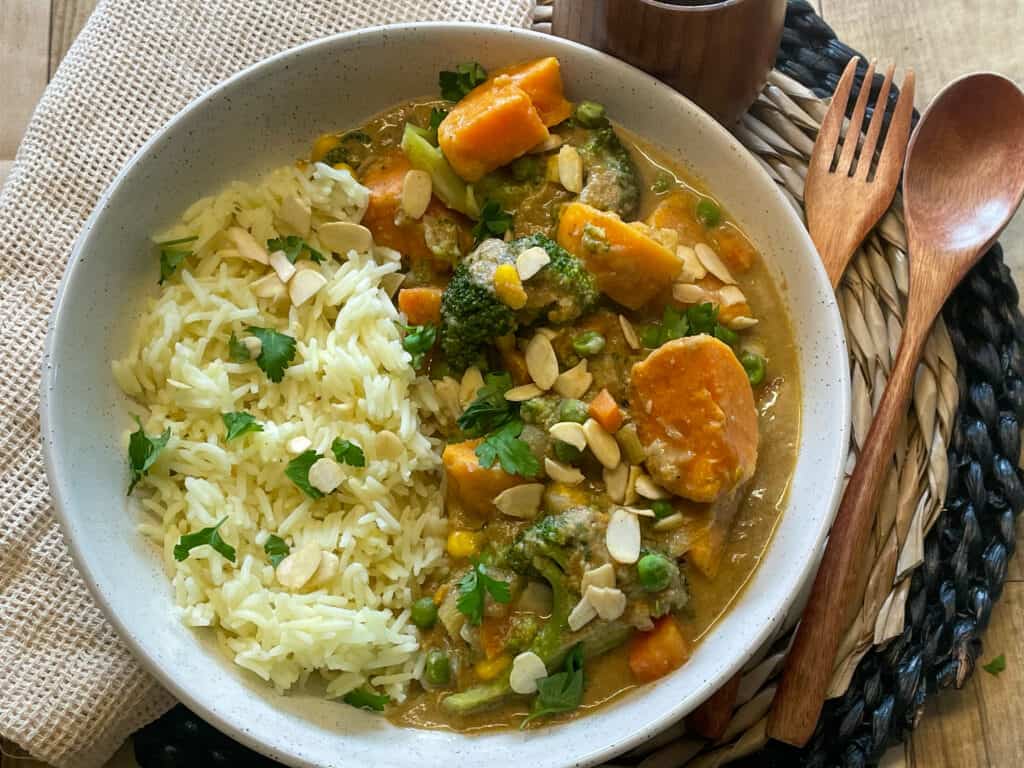
This vegetable curry is the best vegan and vegetarian curry out there if you need a simple, easy and quick midweek curry which uses everyday pantry ingredients. Of course its not authentic but it is packed with the best curry flavours that everyone knows and loves.
Origins of Curry
Dishes made with a variety of ground up spices known as curries have been around for thousands of years and originate in Ancient India. Curry was actually termed kari by the Tamil people.
Curry powder is a blend of different spices and is not actually an Indian invention. Authentic Indian curries grind each spice into a powder and tend not to actually use a ready-made curry powder.
Curries in India are traditionally prepared with a variety of meats as well as vegetables and pulses. Coconut milk or cream, yogurt, tomato paste, ghee, butter and stock or broth are all common additions along with various spices, peppercorns, and curry leaves.
During the 18th Century the British East India Company, who traded with the Tamil people, developed curry powder as a convenient way to introduce curries to western societies.
Curry powder was brought back to Britain and by the late 1700s curries were on the menu in many restaurants with the first curry eating establishment founded in 1810 London.
Vegan Veggie Curry
I can't imagine life without curries as they bring countless interesting and creative flavours and textures. The aromas that are produced when a curry is bubbling away is just amazing.
The basic ingredients for this best ever vegetable curry sauce is peanut butter, onion, garlic, celery, carrot, curry powder, garam masala, creamed coconut and vegetable stock. All these flavours work together to provide a traditional curry sauce similar to the ones popular at British chip shops ot take-outs.
Chuck in a load of your favourite vegetables and cook everything up and that's all there is to it. I simply use whatever veggies I happen to have in my fridge or freezer. Although sweet potato, frozen peas and corn are generally a must as my kids love them.
If your allergic to nuts or just don't like peanut butter you could sub out the peanut butter for an extra tablespoon or two of creamed coconut. Or perhaps use some sunflower seed butter although I have never tested this curry with this type of seed butter. Almond or cashew butter would also work just as well.
I generally add creamed coconut to this veggie curry as a block is much cheaper than a can of coconut milk and the remaining creamed coconut keeps well in the fridge for a few months. A creamed coconut block should be enough for 2-4 curries and it just works beautifully to thicken up the curry and provide delicious creaminess.
However if you can't access any creamed coconut try subbing it for a ¼ cup of desiccated coconut either as it is or whizz the coconut to a fine powder using a blender or a nut/coffee bean grinder. I have used desiccated coconut a few times and it works perfectly well.
This easy vegan vegetable curry is simply the best curry for vegans, vegetarians, plant-based, and anyone looking to eat more vegetables! This veggie curry recipe is so good for using up leftover cooked vegetables. Frozen vegetables work well too. As do slightly wilted vegetables lurking around the fridge! Also reduced vegetables from the bargain bucket of the supermarket are perfect, they will be given a new lease of life within the rich curry sauce.
If you love easy family curry recipes then do check out some more of my family's favourites, this Thai Sweet Potato Curry is one of our best, and we do love this easy chuck it all in the slow cooker Cauliflower Tikka Masala and this amazing Old-School Vegan 'chicken' Curry just hits the Take-Out at home spot!
Serve the best vegan curry with a side of fluffy rice, a sprinkle of chopped coriander [cilantro] and a few toasted almond flakes or crushed peanuts. A warm naan bread to soak up the tasty curry sauce is usually welcomed by everyone.
How to prepare the best vegetable curry
At the moment there is no step-by-step photos for this recipe as this post was originally posted on to the blog a few years ago and we didn't realize the importance of process shots! However, do look out for new photos which will be added soon as this curry recipe is a frequent flier in our household!
However, this recipe begins with gently boiling the diced carrot, celery, onion and garlic in some vegetable broth until they are soft. Alternatively, the diced veggies can be cooked in a little coconut oil but really the recipe does not require additional oil as it is packed with flavour without it.
Next, curry powder, peanut butter, and vegetable broth are stirred through, along with sweet potato chunks. Next in the pan goes creamed coconut, butterbeans, peas, sweetcorn and broccoli. After a wee cook and the veggies have softened, the sauce is checked for seasoning with salt and pepper added to taste, and garam masala powder finishing off the tastiness.
We love some chopped fresh coriander [cilantro] and some toasted almond flakes chucked over the finished curry, as well as a side of basmati rice. My kids always want naan breads or flat breads as they are always hungry!

Recipe notes and frequently asked questions
Storage
Leftovers can be stored within a covered container in the refrigerator for up to 3 days. Or frozen for 2-3 months. Thaw within the refrigerator, before reheating.
Reheating
Leftovers can be reheated in a non-stick pan by bringing to a simmer, and heating for 3-4 minutes until piping hot. Add an extra splash of vegetable broth or coconut milk to loosen the sauce if necessary.
Or reheat the leftover curry using a microwave, by placing into a microwave safe bowl and heat for 1 minute, stir, then continue heating for a few minutes or until piping hot. Its important to stir a few times while reheating in a microwave to prevent cold spots which is where a part of the food does not get reheated.
Yes. It is easy to prepare this recipe as gluten-free with a few considerations. Ensure that your vegetable broth is certified gluten-free, and that your curry powder and garam masala does not have added ingredients that may contain gluten.
Of course, feel free to substitute any of the vegetables and use a different bean if preferred. Also switch out the peanut butter for cashew, almond or sunflower seed butter. Lastly any curry powder can be used, such as mild, medium, hot, Tikka, Madras, etc.
A few ideas:
* Add a few cups of spinach just before serving as the leaves will wilt and cook in seconds.
* Add chopped kale, spring greens, collard greens, chard, etc about 8 minutes before the end of cooking time.
* Shred, grate or fine dice about an inch piece of fresh ginger and sauté along with the onions and garlic.
Rice: A simple and classic option is to serve the curry with some cooked white or brown rice.
Naan bread: Indian naan bread is a delicious accompaniment to any curry. Or try these easy home-made 3 Ingredient Flatbreads. They are my kids favourite.
Roti: Another Indian flatbread that goes great with curry.
Quinoa: If you want to switch up the grains, try serving the curry with some cooked quinoa for a healthy, protein-packed option.
Salad: A simple green salad with a light dressing is a refreshing contrast to the rich and spicy curry.
Chutney or Pickles: A spicy chutney or tangy pickle can add a burst of flavor to the dish.
Raita: A refreshing yogurt-based condiment that helps balance the spiciness of the curry. Use vegan plain yogurt.
Broccoli or cauliflower rice: with a food processer grind the veggies to create small pieces similar to rice or do it by hand with a cheese grater or just a sharp knife (chop into tiny pieces). Next spread out your cauliflower rice on a baking tray and roast at 180 Fan/ 200 Celsius/ 400 Fahrenheit/ Gas 6 for 25-30 minutes until it looks nice and toasted. Give it a stir half way through cooking for even browning.
Potato chips, fries or potato wedges: to prepare oil-less crispy wedges simply chop your potatoes and add some seasoning such as garlic powder, paprika, potato seasoning blend, etc. Roast on a baking tray at 180 Fan/200 Celsius/400 Fahrenheit/Gas6 for about 25-40 minutes, depending on how thick the wedges are, until brown, crispy and soft. Flip over half way through roasting. Or cook the potatoes using an air-fryer. Of course a tablespoon or two of oil can be added for extra crispy chips.
Fresh herbs: Chopped fresh herbs such as coriander, [cilantro] or parsley can add a pop of color and fresh flavor to the curry.
Lime or lemon wedges: A squeeze of fresh lime juice can brighten the flavors of the curry and add a citrusy zing.
Toasted nuts: Chopped, toasted nuts such as cashews, almonds or peanuts can provide a satisfying crunch and nutty flavor. If your allergic to nuts try toasted sunflower or pumpkin seeds.
Coconut flakes: Toasted coconut flakes can add a sweet, tropical flavor and texture to the dish.
Sliced green onions [spring onions]: Thinly sliced green onions can add a subtle onion flavor and a touch of green color to the curry.
Red chili flakes: For those who like a little extra heat, a sprinkle of red chili flakes can add some spice and color.
Pomegranate seeds: Pomegranate seeds can add a juicy burst of sweetness and a beautiful pop of red color.
Curry fried rice: Heat up some leftover rice, add the curry and some veggies like chopped carrots and peas, and stir-fry them together with some oil in a pan. It's a quick and easy way to make a flavorful and filling meal.
Curry soup: Add some vegetable broth and coconut milk to the leftover curry and simmer until heated through. You can also add more veggies or beans to make the soup even more filling.
Curry wrap: Spread some hummus or mashed avocado on a wrap, add the leftover curry and some fresh greens, and wrap it up for a tasty and nutritious lunch.
Curry shepherd's pie: Layer the leftover curry in a baking dish, top with mashed potatoes, and bake until the top is golden brown. This is a hearty and comforting meal.
Curry stir-fry: Add the leftover curry to a stir-fry with your favorite veggies, tofu, or protein of choice. Serve over rice or noodles.
Curry tacos: Heat up the curry and serve it in taco shells or tortillas with your favorite toppings like avocado, cilantro, and lime wedges.
Curry powder is a spice blend that varies widely in ingredients and flavor depending on the region and cuisine it is associated with. There are many different types of curry powders available, and the "best" one depends on personal taste and the type of dish you are making. Here are some popular types of curry powder:
Indian curry powder: This is a blend of spices commonly used in Indian cuisine, such as cumin, coriander, turmeric, and cinnamon. It's a versatile blend that can be used in many different dishes, including vegetable curries and rice dishes.
Thai curry powder: This is a blend of spices used in Thai cuisine, including coriander, cumin, turmeric, ginger, and lemongrass. Thai curry powder is used to make Thai curries, which are often made with coconut milk, and are known for their spicy, sweet, and sour flavors.
Japanese curry powder: This is a milder blend of spices used in Japanese cuisine, including turmeric, cumin, coriander, and ginger. Japanese curry is often made with meat and potatoes and has a sweeter and milder flavor than other types of curry.
Jamaican curry powder: This is a blend of spices commonly used in Jamaican cuisine, including allspice, turmeric, cumin, and coriander. Jamaican curry powder is known for its rich, spicy, and earthy flavor and is often used in Jamaican-style chicken or goat curry.
Malaysian curry powder: This is a blend of spices used in Malaysian cuisine, including turmeric, cumin, coriander, fennel, and chili powder. Malaysian curry is known for its fragrant and spicy flavor and is often used in dishes made with coconut milk.
Any Indian curry powder that's available in your local store or supermarket is perfect for vegetable curry. The type of curry powder that we love using is Madras as its got that authentic curry flavour that just makes your mouth water when the curry aromas are diffused during cooking. Its my favourite cooking aroma for sure.
Garam masala is a popular spice blend used in Indian cuisine. The name "garam masala" means "hot spice blend" in Hindi, but it does not necessarily mean that it is a spicy blend. I love adding garam masala to this vegetable curry recipe as it just adds so much extra flavour without extra hot spice, so don't be concerned that adding garam masala to your curry will make it too spicy, it won't just tastier!
Garam masala is made by grinding together whole spices such as cinnamon, cloves, cardamom, black pepper, and cumin seeds. The exact blend of spices used can vary depending on the region and personal preferences. Some recipes also include coriander seeds, nutmeg, fennel seeds, or bay leaves.
Garam masala is added to dishes towards the end of the cooking process, or sometimes sprinkled on top of the dish just before serving, to add depth of flavor and aroma. It is often used in Indian dishes such as curries, vegetable dishes, and soups.
The warm and complex flavors of garam masala complement the sweetness of coconut milk and the heat of chili peppers commonly used in Indian cooking.
More of the best vegan curry recipes:
***please note: for US measurements click the 'US customary button' within the recipe and the measurements will switch to tablespoons, cups, and ounces.***
📖 Recipe
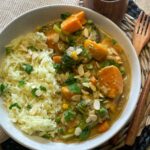
The best easy vegetable curry!
Equipment
- Non-stick skillet or a deep fry [saute] pan or similar with a lid
Ingredients
To sauté vegetables:
- 250 millilitres vegetable broth or 1 tablespoon olive oil or coconut oil
Curry:
- 1 medium onion diced
- 2 medium carrots chopped into small dice
- 2 sticks celery diced
- 4 cloves garlic diced or minced
- 360 grams sweet potato chopped into chunky bite sized pieces
- 1 tablespoon Madras curry powder use mild, medium or hot variety to taste
- 60 grams peanut butter Alternatively use cashew, almond or sunflower seed butter.
- 850 millilitres vegetable stock
- 50 grams creamed coconut block
- 300 grams broccoli 1 head of broccoli chopped into florets
- 130 grams frozen peas
- 130 grams frozen sweetcorn
- 1 can butterbeans 400g/14oz can drained, 240g cooked beans, replace with any other bean
- 2 teaspoons garam masala powder
To Garnish, optional
- 10 grams coriander[cilantro] chopped
- 20 grams flaked almonds or broken cashew or peanuts
To Serve, optional
- 250 grams basmati or long grain rice cooked according to packet instructions
Instructions
Sauté:
- Over a medium heat sauté the onion, garlic, carrot and celery in the vegetable broth for about 8 minutes until the veggies soften. Cover your pan with a lid and stir a few times to prevent sticking. Add a few tablespoons of extra broth as required.Alternatively saute over a low-medium heat for 5 minutes in olive or coconut oil, stirring frequently.250 millilitres vegetable broth, 1 medium onion, 2 medium carrots, 2 sticks celery, 4 cloves garlic
Prepare the rest of the curry:
- To the sautéed veggies add the curry powder, peanut butter and vegetable broth, mix well to incorporate the peanut butter.Tip in the sweet potato and add a lid to the pan.1 tablespoon Madras curry powder, 60 grams peanut butter, 850 millilitres vegetable stock, 360 grams sweet potato
- Simmer for around 10 minutes.
- Meanwhile begin to prepare any accompaniments such as rice.250 grams basmati or long grain rice
- Remove the lid and add the creamed coconut. It will melt as it heats so give the sauce a stir every now and again to help mix the coconut through.Add the broccoli, sweetcorn, peas and butterbeans.Stir well and push the broccoli down into the sauce.50 grams creamed coconut block, 300 grams broccoli, 130 grams frozen peas, 130 grams frozen sweetcorn, 1 can butterbeans
- Simmer for about 10 minutes. Mix the broccoli a few times so that it can cook through on all sides.
- The sauce may look thin but it will thicken up once off the heat and it begins to cool.Although if somehow your sauce is too thick for your liking just add a little extra vegetable broth.
- Once the sweet potato and broccoli are fork tender add the garam masala and mix well. Check the seasoning and add salt and pepper to taste.2 teaspoons garam masala powder
Garnish and serve
- Scatter coriander and flaked almonds if using over each serving. Serve with your chosen accompaniments.10 grams coriander[cilantro], 20 grams flaked almonds
Notes
- The following nutritional data is for guidance only and is not a strict calculation as ingredients vary.
- Nutritional info does not include the rice but does include the coriander and flaked almonds.
- Leftovers will keep fresh in the fridge for 3 days, within a covered container.
- Or frozen for 2-3 months. Defrost before reheating.
- Reheat by adding to a skillet or pan, and bring to a simmer for 3-4 minutes until everything is heated through. A little extra veggie broth or some coconut milk may be required to loosen up the sauce.
- A scoop of reheated curry leftovers is so tasty served over a slice of toasted bread or with a leftover naan or flatbread for next days lunch.
- For a creative lunch use leftover curry as a grilled vegan cheese toastie filling. My kids especially love these for lunch.
Nutrition
Thank you for trying out our best vegan vegetable curry recipe! We hope you enjoyed making and savoring it as much as we do.
If you tried this recipe, please let us know in the comments below how it turned out for you, or if you made any modifications.
If you share your creations on social media, don't forget to tag us (@traditionalplantbasedcooking) and use the hashtag #traditionalplantbasedcooking, so we can see your scrumptious dishes!
Lastly, if you found this recipe helpful, please share it with your friends and family, so they can enjoy it too.
Thank you, and happy cooking!
Love, Jacq x


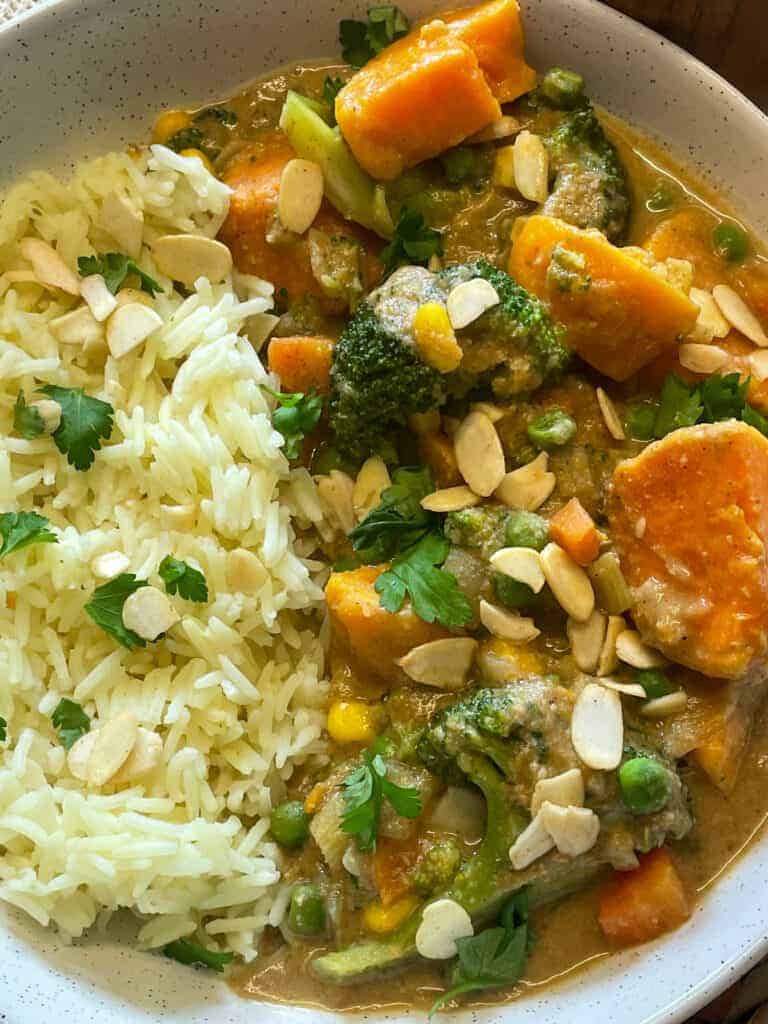
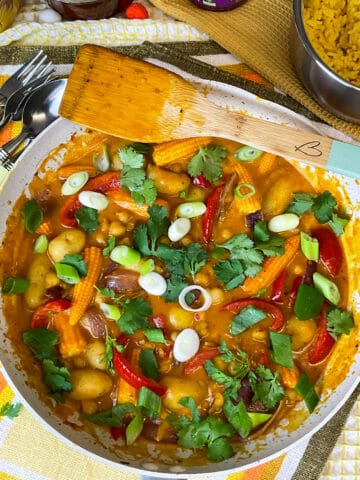
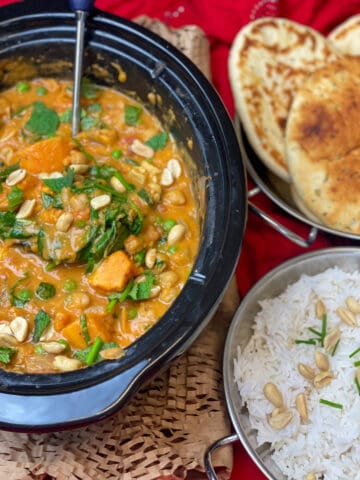
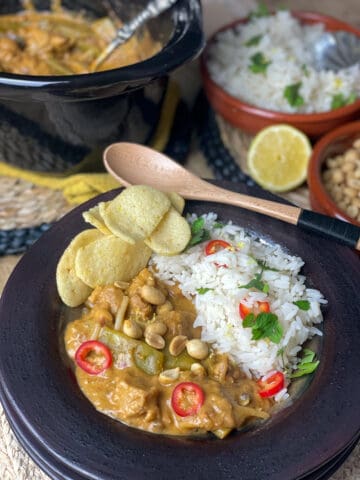
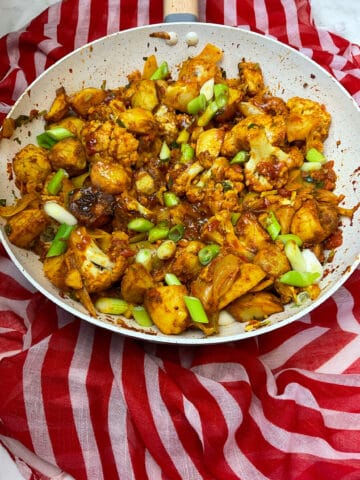
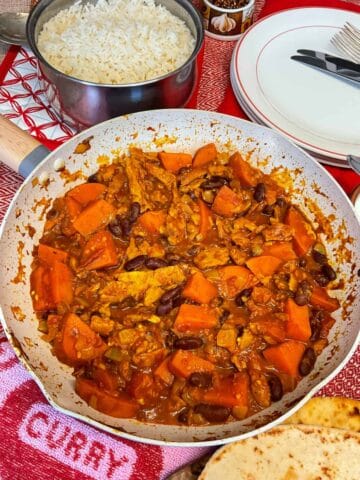
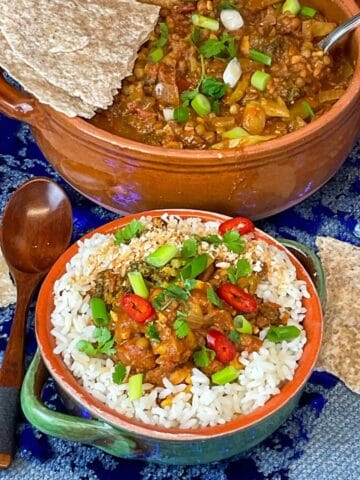
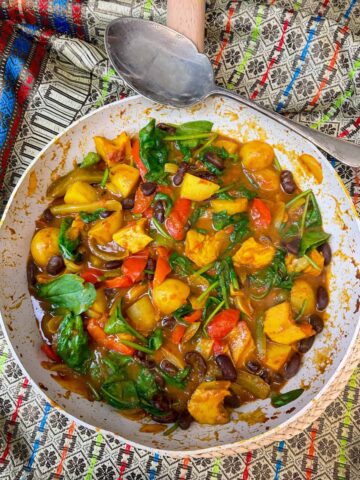
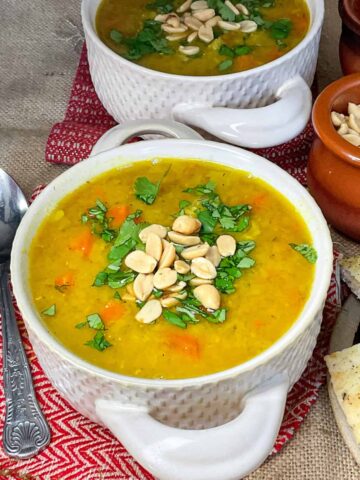
Leave a Reply